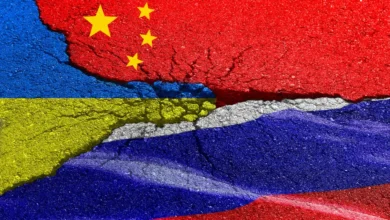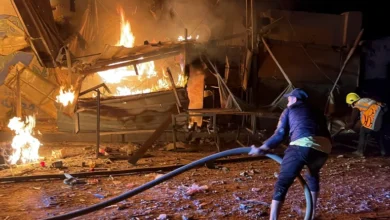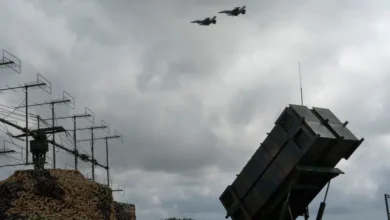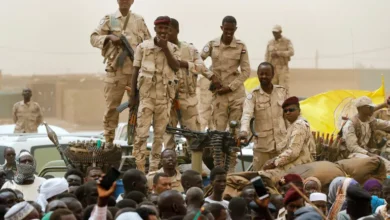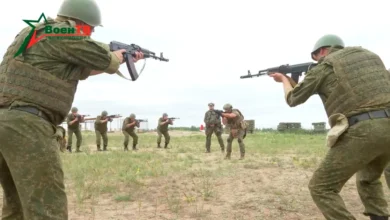‘Our bodies know the pain’: Why Norway’s reindeer herders support Gaza

A herd of reindeer running through thick, white snow sounds a bit like thunder.
It is a spectacle that has been replayed for at least the past 10,000 years on eastern Norway’s Fosen Peninsula and one that Maja Kristine Jama, who comes from a family of reindeer herders, is deeply familiar with.
Like most Sami reindeer herders, Jama knows every inch of this terrain without any need for a map.
Instead of going to kindergarten like most other children in Norway, she was raised living outdoors alongside the migrating reindeer. Reindeer husbandry in Norway is a sustainable activity that is carried out in accordance with the traditional practices of Sami culture. Reindeer also play an important role in the Arctic’s ecosystem and have long been a symbol of the region
“Reindeer herding defines me,” Jama says. “We are so connected to nature, we have respect for it. We say that you don’t live off the land, you live within it. But we see our lands being destroyed.”
Europe’s oldest and last remaining Indigenous people are under grave threat as a result of borders, land seizures, construction projects dedicated to the extraction of natural resources and systematic discrimination.
Yet, that creeping sense of suffocation has made the Sami reach out to another set of Indigenous people nearly 4,000km (2,500 miles) away, whose fight for survival they identify with: the Palestinians in the Gaza Strip and the occupied West Bank.
Their own struggle for Indigenous rights and self-determination has turned the Sami into vocal advocates for the Palestinian cause.
As the death toll mounted, anger about Gaza quickly spread through Norway generally and the Sami community in particular. Scores of Norwegians posted images of themselves holding “Stop bombing Palestine” placards on social media while mass demonstrations called for an immediate ceasefire after Nordic countries, with the exception of Norway, abstained from a United Nations General Assembly ceasefire vote on October 27.
For the Sami, it was a pivotal moment of two causes tangling into one. The community launched a series of regular protests in Oslo against the war in Gaza, and those rallies continue to take place.
In front of the Norwegian Parliament on a cold October day, surrounded by hundreds of Palestinian and Sami flags, Isaksen held a mic and performed the “joik”, a traditional Sami song performed without instruments. Her lilting sounds brought the noisy demonstrators to a standstill, carrying a prayer that she hoped would somehow reach the besieged children of Gaza.
“I’m physically so far away from them, but I just want to grab them, hold them and take them out of this nightmare,” Isaksen says.
“Without trying to compare situations, Indigenous peoples all over the world have stood up for the Palestinian people because our bodies know the pain of being displaced from our homes and forced out of our own lands,” Isaksen says.
A long struggle
For more than 9,000 years, the Sami lived a free, nomadic existence spanning modern-day Norway, Sweden, Finland and Russia. That began to change in the ninth century when outsiders from Southern Scandinavia encroached into Sapmi, the name given to the broad, untamed lands of the Sami. Christian invaders established a church in the 13th century in Finnmark in northern Sapmi territory in what is now northern Norway.
Sweden’s break from Denmark, which had also ruled Norway, in 1542 launched an era of land disputes, conflict and coercion of the Sami that lingers today. A Swedish census that has been preserved from 1591 notes how one Sami community, moving across borders that hadn’t existed for their ancestors, simultaneously paid taxes to Sweden, Denmark and Russia.
The creation of Europe’s longest unbroken border in 1751 – between Norway and Sweden – was particularly disastrous for the Sami, restricting them permanently within one country, splitting families apart and forcing their reindeer away from migratory routes.
As has been the case for the Palestinians, the imposition of such borders has had a direct impact on the Sami’s fragile existence, says Aslat Holmberg, president of the Sami Council, a nongovernmental organisation promoting the rights of the Sami people across the Nordics and western Russia. He comes from an area on the border between Finland and Norway.
“I don’t like to divide the Sami with borders, but we are people now living in four countries,” Holmberg says.
Although Sami groups maintain a bond, they believe the borders imposed on them were one of many colonial acts that tore them apart. A ban on speaking their own language under forced assimilation policies, which officially ended in the 1960s in Norway, almost erased their cultural ties. Holmberg warns that Sami languages are now “endangered”.
He isn’t exaggerating.
There are no historical records showing population figures for the Sami through history. Today, however, they are estimated at 80,000. About half that number live in Norway, where just three Sami languages remain in use. There are only 20 remaining speakers of one of them – the Ume language used in Sweden and Norway.
In all, there are nine surviving Sami languages, which are related to languages such as Estonian and Finnish.
Preservation of these languages is fraught with difficulties. In Finland, 80 percent of Sami youth live outside traditional Sami territory, where there is no legal obligation to offer their language services in government and the judicial system. By comparison, Swedish language services in legal and government administration are mandatory in Finland.
Dying languages and disruptions from borders are not the only problems faced by the Sami. Climate change and land seizures for the extraction of natural resources also threaten livelihoods.
Small-scale gold mining and forestry, both legal and illegal, are common. The mining of nickel and iron ore, which is considered part of the European Union’s mission for self-sufficiency, have restricted reindeer from roaming and have destroyed their feeding grounds.
According to Amnesty International, mining companies are now showing interest in digging up Sami territory in Finland to feed the ever-rising demand for mobile phone batteries.
“We live in a settler colonial society,” Holmberg says. “The Sami know how it is to be marginalised and lose our lands. The levels of violence are different in Palestine, but a lot of the underlying mindset is similar. The US and Europe have shown they are not able to fully acknowledge their own colonial history.”
Holmberg delivers a stark warning that sounds eerily similar to the voices heard in Palestine.
